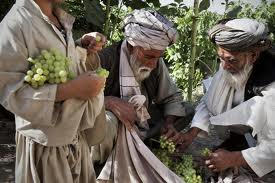
As for the Afghan government, it remains all but invisible, even though Karz is the ancestral home of President Hamid Karzai. “The government itself has not done anything,” said Abdul Ali, a village elder.
The United States and its allies have devoted years of effort and billions of dollars to improve the delivery of basic services in rural Afghanistan. If Afghan leadership were to have taken hold anywhere, it might well have been in Karz, a farming area on the outskirts of Kandahar city still populated by relatives and tribesmen of the man who has ruled Afghanistan through a decade of war.
Instead, what is emerging in ever starker relief is a governance vacuum as U.S. forces begin to draw down. As the Americans leave, taking with them a main source of economic stimulus, U.S. officials and residents say what worries them most is the weakness of the local and provincial governments being left behind, which command virtually no resources and almost no authority.
That lack of government progress is apparent every day in Karz with the line of villagers beating a path to Hashmat Karzai’s door.
Karzai holds no official post; his prominence in the village stems from his status as a prosperous and powerful tribal elder and his relationship with the president. He is the former owner of a private security company, Asia Security Group, which sent men to guard U.S. bases, and he currently rents out land for a hotel near NATO’s Kandahar Airfield.
And yet each day the villagers of Karz file into Karzai’s courtyard with a fresh list of problems they say they can find no audience for in the offices of government. One by one they plead for electricity for their irrigation pumps, a clinic for their sick children, or information on the whereabouts of a relative detained by American troops.
“Where should he go? Which door should he knock?” Hashmat Karzai said as he motioned to one of his supplicants. “This is what’s killing the people of Kandahar. You go try to see the governor, it’s impossible to see him. The police chief? The mayor? It would take a month to see them.”
“There’s a distance between locals and the government. There’s a big gap,” Karzai said. “How are you going to cover that gap? I haven’t figured it out yet.”
‘Not delivering the services’
By September, the number of U.S. troops in Kandahar and other, nearby provinces will drop to 13,500, down from a high in April 2011 of nearly 20,000. The bloody battles with the Taliban of the past few years — in Kandahar city and the nearby Arghandab Valley — have shifted farther west, into the rural minefields of Zhari and Panjwai districts.
While the locus of violence has changed, the overall strength of the insurgency has stayed about the same, according to Maj. Gen. James L. Huggins Jr., the top American commander in Kandahar province. He says he is confident that the Afghan soldiers and police can prevail in a fight with the Taliban.

